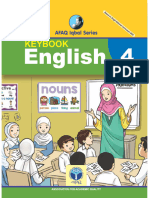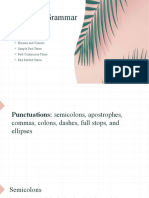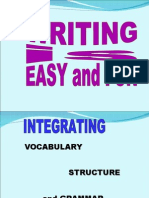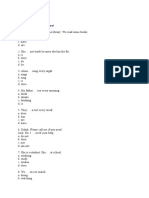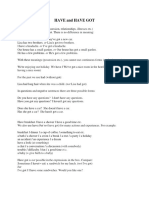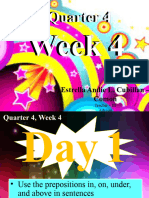Bahasa Inggeris - Year 4 Grammar, Spelling, Punctuation and Text Completion Grammar, Spelling and Punctuation
Bahasa Inggeris - Year 4 Grammar, Spelling, Punctuation and Text Completion Grammar, Spelling and Punctuation
Uploaded by
Mangala RaniCopyright:
Available Formats
Bahasa Inggeris - Year 4 Grammar, Spelling, Punctuation and Text Completion Grammar, Spelling and Punctuation
Bahasa Inggeris - Year 4 Grammar, Spelling, Punctuation and Text Completion Grammar, Spelling and Punctuation
Uploaded by
Mangala RaniOriginal Title
Copyright
Available Formats
Share this document
Did you find this document useful?
Is this content inappropriate?
Copyright:
Available Formats
Bahasa Inggeris - Year 4 Grammar, Spelling, Punctuation and Text Completion Grammar, Spelling and Punctuation
Bahasa Inggeris - Year 4 Grammar, Spelling, Punctuation and Text Completion Grammar, Spelling and Punctuation
Uploaded by
Mangala RaniCopyright:
Available Formats
BAHASA INGGERIS - Year 4 GRAMMAR, SPELLING, PUNCTUATION AND TEXT COMPLETION GRAMMAR, SPELLING AND PUNCTUATION.
(i) GRAMMAR Introduction
UPSR Model Questions and Answers. Questions 16 - 21 Choose the best answer to complete the sentences.
16.
The cat is sleeping ___________ the table. A on B under C below D behind Question 16 : The anwer is B. You can get the answer by looking at the picture. 17.
Khaty is ___________ to her house. A jogging B running C walking D hopping Question 17 : The answer is C. You can get the answer by looking at the picture. 18. The __________ boy ate his sandwich quickly. A angry B hungry C naughty Question 18 : The answer is B. The boy ate quickly because he was hungry, not because he was being naughty or feeling angry. 19. The baby cried loudly _________ she was hungry. A but B and C because
Question 19 : The answer is C. The baby cried because of a reason; she was hungry. 20. Last week, my family and I _________ to the KLCC. A go B went C gone Question 20 : The answer is B. The sentence is in the simple past tense form. Choose the word that has the opposite meaning as the word underlined. 21. His daughter is fat but his son is _______. A kind B sick C thin Question 21 : The answer is C. The opposite meaning of fat is always thin. A. NOUNS Nouns are words that name people, places, animals and things. Common Nouns Common nouns refer to people, places, animals and things of the same class or kind. Examples:
Proper Nouns Proper nouns refer to particular people, places, animals and things. Proper nouns always begin with capital letters. Examples:
Countable and Uncountable Nouns Nouns can be countable and uncountable. (i)Countable nouns are nouns that can be counted such as pencils, apples, people and cars. (ii) Uncountable nouns are nouns that cannot be counted such as water, salt, sugar and sand.
Phrasal quantifiers are used to count uncountable nouns. Among the examples are a glass of milk, a bowl of rice, a spoon of sugar and a packet of salt. Look at the list of phrasal quantifiers below:
1. Would you like a cup of tea? 2. Rita eats two slices of bread every morning. 3. How many packets of biscuits did you buy? 4. We can see a range of mountains from here. 5. Mani wanted to buy a bottle of oil from that shop. 6. Can you please add a pinch of salt to my bowl of soup? 7. I gave my mum a box of chocolates for Mother's Day this year. 8. I usually drink a glass of milk before I go to sleep at night. 9. That group of islands was washed away during the recent tsunami. 10. To make sardine sandwiches, you will need a loaf of bread and a can of sardines.
Note Quantifiers can be used with countable and uncountable nouns. Look at the list of quantifiers below:
1. Is there any rice left in the pot? 2. I need some money to buy new books. 3. There is only a little water left in the bottle. 4. A lot of people enjoyed that entertaining movie. 5. A small number of students were absent yesterday. 6. Much time was wasted waiting for the bus to arrive. 7. Several pupils in this class scored full marks in the test. 8. You need only a small amount of sugar to make this cake. 9. Some durians taste very sweet but a few do not taste sweet at all. 10. There are many oranges in the crate but only a few can be eaten.
Singular and Plural Nouns Singular nouns stand for one person or thing such as boy, cat, toy and apple. Plural nouns stand for more than one person or thing such as boys, cats, toys and apples. You need to add -s or -es to change them into plural nouns. Examples:
Besides that, you need to add -s or -ies to words ending in -y. Examples:
You can change singular nouns to plural nouns by changing the inside vowel. Examples:
You can change singular nouns to plural nouns by adding -en. Examples:
You can change singular nouns to plural nouns by adding -s to special nouns. Examples:
However, some nouns are only used in the plural form. Among them are scissors, trousers, shorts,clothes and spectacles. B. PRONOUNS Pronouns are words that replace nouns. Examples:
The word She replaces the noun Mary. Therefore, She is a pronoun. Personal Pronouns Personal pronouns can be the subject or the object in a sentence.
(i) If a pronoun is used as a subject, use it immediately before a noun. (ii) If a pronoun is used as a object, use it after a verb or a preposition.
1. Please give that book to me. 2. I am the monitor of this class. 3. She talks to him when he is free. 4. You need to buy a new pair of shoes. 5. Can you return Roshan's book to him? 6. Azman was late because he missed the bus. 7. I do not see you talking with her nowadays. 8. We were early so the teacher praised us. 9. Hida and Azizi always carry their books with them. 10. The cat finished the food because it was very hungry.
Possessive Pronouns and Possessive Adjectives Possessive pronouns are pronouns that show possession. They occur at the end of a sentence. Possessive adjectives also show possession. However, they occur before a noun.
Interrogative Pronouns Interrogative pronouns are used to introduce questions.
Demonstrative Pronouns Demonstrative pronouns are pronouns that point out a person or a thing. Examples: 1. Who gave you this bag? 2. These books are brand new. 3. Anis lives in that house over there. 4. Please put these fruits in this basket. 5. This papaya tree bears a lot of fruits.
C. ADJECTIVES Adjectives are words to describe nouns. They describe more about the shapes, sizes and colours of nouns. Examples:
1. My brother has a big blue van. 2.Zana's cat has white fur and a short tail. 3. Please put this round tin on that square table. 4. The red rose in that tall vase looks very fresh. 5. My parrot has green, red and yellow feathers. 6. Erlina likes to wear purple shirts and blue jeans. 7. The boy threw small pebbles into that shallow pond. 8. My mum bought a small bag with a long strap for my sister. 9. He managed to swim across that wide river without any problems. 10. That tall boy standing next to the large building is my cousin, Sam. Positive, Comparative and Superlative Adjectives have three degrees of comparison: positive, comparative and superlative.
- The positive form is used when no comparison is made. - The comparative form is used to compare two nouns. You need to add -er to the adjectives of comparison and the word than after that. Examples: 1. I am older than my sister. 2. He is taller than the teacher. - The superlative form is used to compare three or more nouns. You need to add -est to the adjectives and the in front of it. Examples: 1. Reza is the smartest boy in class. 2. Kasturi is the prettiest among her sisters. Other examples:
The words more and most are used for adjectives of three or more syllables. They are also used with some adjectives with two syllables. Examples:
1. Her house is more beautiful than mine but his house is the most beautiful. 2. She was more cheerful yesterday than on Monday but today she is the most cheerful. Some adjectives are compared irregularly. Examples :
D. PREPOSITIONS Prepositions are words used before nouns or pronouns to show location or direction. (i) Prepositions of location show place and position. Examples: in, on, under, next to, behind, between, among and against. (ii)Prepositions of direction show the direction of things. Examples: through, over, across, along and to. 1. Please do not sit on this chair. 2. Shahrulliza sits beside me in class. 3. He put the bottles of milk in the box. 4. The bird flew swiftly over the building. 5. There is a cat sleeping under the chair.
E. ARTICLES Indefinite Articles There are two types of articles: indefinite articles and definite article. Indefinite articles consist of a and an. 1. An is used before a singular noun that begins with a vowel sound. Examples: - an apple - an honest boy - an umbrella 2. A is used before a singular noun that begins with a consonant sound. Examples: - a hotel - a rope - a boy Definite Article Definite article consists only of the. It is used: 1. to refer to a particular person or thing (i) The man over there is my uncle. (ii) The house on the hill belongs to a rich family. 2. in front of objects which are the only one of their type (i) The earth revolves around the sun. (ii) The sun is shining very brightly today.
3. when a word is mentioned the second time (i) I bought a pen. The pen is expensive. (ii) Mum gave me a gift. The gift was for my birthday. 4. with superlative adjectives (i) Herry is the tallest boy in class. (ii) This is the most expensive car I have seen.
F. CONJUNCTIONS Conjunctions are used to join words, phrases or sentences together. Examples: and, or, but, because and so. 1. And is used to combine things of similar value or function. (i) It was hot and dry yesterday afternoon. (ii) Mum bought some apples and oranges at the fruit stall. 2. Or is used to show choices. (i) Would you like some coffee or tea? (ii) You can stay here or come along with me. 3. But is used to show contrast. (i) He studied hard but he did not pass the test. (ii)The police chase the thief but they did not manage to catch him. 4. Because is used to show reason. (i) He was late because he missed the bus. (ii) We could not play football because it was raining. 5. So is used to show the result of something.
(i) It was raining so we could not play football. (ii) He did not do his homework so he was scolded by the teacher.
G. ADVERBS Adverbs of Manner Adverbs of manner are used to describe how something is done. 1. The girl sang sweetly. 2. He ran away quickly. 3. I did my work carefully. 4. The boys walk happily. 5. Sheila eats hungrily. 6. The wire bends straightly. More than and most are used when comparing adverbs of manner that end with -ly.Examples: 1. He did his work more neatly than I did. 2. Mani shouted most loudly among us. Adverbs of Time Adverbs of time are used to tell when an action happened.Examples: 1. The bus will arrive soon. 2. Last year, I was in Year 5. 3. Did they go to school yesterday? 4. My sister is cooking in the kitchen now. 5. We went to London for a holiday last year.
Adverbs of Frequency Adverbs of frequency describe how often a certain action is done.Examples: 1. It does not rain every day. 2. Syahida is sometimes late for class. 3. She is always absent from school. 4. The children walk to school every day. 5. I always wait for my friend at the bus stop.
H. MODALS Modals are words used to express functions of verbs.
I. TENSES The Simple Present Tense The simple present tense is used: (i) to show habitual action and action that takes place at the present time 1. They are very noisy. 2. My brother has a pet. 3. We walk to school every morning. 4. My mum always cooks our lunch. (ii) to give instuction and directions 1. Give me the book. 2. Add some sugar in the tea. 3. Walk straight along this road. (iii) to state general truths or statements 1. The sky is blue. 2. Rivers flow in to the sea. 3. The sun rises in the east. (iv) in imperative sentences 1. Go away! 2. Keep quiet! 3. Look at me! For singular verbs in the present tense, you need to add -s, -es or -ies. 1. Nadia keeps her dresses neatly.(keep) 2. Husna catches a big butterfly.(catch)
3. He tries to open the door by himself.(try) 4. The scientist studies the insects.(study)
The Present Continuous Tense The present continuous tense is used to show an action that takes place at the time of speaking. The verb to be such as am, is or are are placed before the verbs. Then, -ing is added to the verbs. 1. I am eating an apple. 2. Laila is cycling to the school. 3. The boys are playing football in the field. 4. The farmers are watering the field together. 5. The goldfsih is blowing bubbles in the fish tank.
The Present Prefect Tense The present perfect tense is used: (i) to show an action that has happened or was just completed 1. It has just stopped raining. 2. I have finished cleaning my room. 3. Patrick and Joan have just arrived from New York. (ii) to show an action which began in the past and still continuing into the present 1. I have never been to London before. 2. They have lived in Kuala Lumpur since 1990. 3. Mike has worked in this office for a long time. (iii) in passive sentences to show actions which took place at an indefinite time in the past 1. I have painted the wall. 2. The car has been repaired. 3. The books have been corrected.
The Simple Past Tense The simple past tense is used to show an action that happened in the past. The verb is and am are changed to was.The verb are is changed to were in the past tense sentence.
For regular verbs in the past tense, -ed is added.
Some verbs are irregular. Therefore, one vowel is changed when they are in the past tense.
For other irregular verbs the spelling are changed; by dropping the e or changing more than one letter.
However, some irregular verbs are the same, whether in the present tense or in the past tense.
In order to signal a past tense sentence, adverbs of time such as yesterday, last night, last week and last year are used. 1. We went to school yesterday. 2. I slept early last night. 3. Hafiz walked to school last week.
The Past Continuous Tense The past continuous tense is used: (i) to describe an action which was happening at a certain time in the past 1. Diana was walking home when she found that wallet. 2. Were they doing their homework when their father arrived.? 3. I was shopping with my husband when I met my friend, Rashid. (ii) to describe two actions going on at the same time in the past 1. Diya was reading while Anneza was writing. 2. My brother was washing his car while whistling a happy tune. 3. The pupils were talking as they were walking to their class.
The Past Perfect Tense
The past perfect tense is used : (i) to show and action that had been completed at a certain time in the past 1. The train had already left when they arrived. 2. I had done my homework when my dad called me. 3. By the time Suraya arrived, we had finished our dinner. (ii) to show that one past action happened before another 1. After Danish had had his lunch, he did his homework. 2. After the baby had cried quite a bit, her mother fed her. 3. Before she could answer the phone, it had already stopped ringing.
The Simple Future Tense The simple future tense is used to show a future action. 1. I shall watch the movie tonight. 2. I shall go on the secondary school next year. 3. We shall borrow books from the library tomorrow. 4. The boy scouts will have a camp fire in school this weekend. 5. Johny and his parents will go on a holiday to Singapore next month.
The Future Continuous Tense The future continuous tense is used to describe an action which will take place later. 1. Musa will be attending tuition class this evening. 2. Will you be meeting your friends at the party tonight? 3. I shall be going to my grandfather's house this weekend. 4. Donna and Karen will be celebrating Mother's Day this Sunday. 5. Salima will be helping her mother at home during the holidays.
VERB FORMS
J.SUBJECT-VERB AGREEMENT The subject in the sentence must always agree with the verb. (i) Singular verbs are used with singular nouns. 1. The girl is present today. 2. Faizal walks to school every day. 3. Justynn tries very hard to get full marks in the test. (ii) Singular verbs are used with uncountable nouns. 1. The water is hot. 2. The air feels cold. 3. The light is bright. (iii) Singular verbs are used as collective nouns. 1. Kumutha's family is very small. 2. This bunch of grapes is for you. 3. The school netball team wins the trophy every year.
(iv) Plural verbs are used with plural nouns. 1. The pupils are happy with their results. 2. The boys cycle to school. (v) When two or more subjects are joined with and, plural verbs are used. 1. Yellow and green are my favourite colours. 2. Jamil and Khairil play football for the school team. 3. Hida, Neni and Shah come from the same town.
K. POSITIVE AND NEGATIVE STATEMENTS. Positive statements are statements formed without the word not. Negative statements are statements formed by adding not to positive statements.
Sometimes, some words are changed in order to form negative statements from positive statements.
L. QUESTIONS AND RESPONSES Verbs such as is, are, was, were, do, does and did can be used to start questions. When answering a question, you should use yes to start off positive response and no to start off negative response.
M. QUESTION TAGS AND RESPONSES A question tag is placed at the end of a sentence to form a question. (i) A negative tag is attached to a positive statement when the expected answer is yes. 1. It is noisy, isn't it? Yes, it is. 2. Your mother will come, won't she? Yes, she will. (ii) A positive tag is attached to a negative statement when the expected answer is no. 1. You aren't tired, are you? No, I'm not. 2. Harun didn't sleep late, did he? No, he didn't.
N. SENTENCE TYPES Simple Sentence A simple sentence contains a subject and a predicate. 1. Liana is my friend.
2. We visited our grandparents last weekend.
Compound Sentence A compound sentence contains two or more simple sentences joined by conjunctions such as and, but, so or because. 1. I drew a picture and painted it. 2. Hakim studied hard so he passed his exam. 3. Azmah waters the garden, Sarimah sweeps the floor but Hanim does nothing. SPELLING
Introduction
UPSR Model Questions and Answers. Questions 22-23 Choose the answer with the correct spelling. 22. Look at the ____________ if you want to know today's date. A. celander B. calendar C. celaandr D. calendra Question 22 : The answer is B.In English, if a word starts witk a K sound, it is usually spelt with a C. 23. Puan Munirah gave birth to two ___________ A. baibes B. babeis C. babies Question 23 : The answer is C. A noun that ends with -y is changed to -ies to make it plural. Tips Here are some guides to help you improve your spelling. A. To Change Singular Nouns To Plural Nouns (i) Add -s
(ii) Add -es for nouns that end with -s,-sh, -ch and -x.
(iii) Change nouns that end with -f and -fe to -ves.
(iv) For nouns that end with a consonant + -y, change to -ies.
(v) However, for nouns that end with a vowel + -y, just add an -s.
B. Others (i) The letter q is always followed by u.
(ii) The letters ph sound like f.
(iii) In English, most words that start with a K sound are spelt with a C.
C. Homophones Sometimes, there are words that are pronounced alike but spelt differently.Not only that, these words also carry different meanings.They are called homophones.Some people are confused by these words. Therefore, it is important for you to know the correct spelling for a particular word that you use. Read the list of homophones below to help you know the differences between the words.
PUNCTUATION Introduction
UPSR Model Questions and Answers. Questions 24-25 Choose the sentence with the correct punctuation. 24. A. What are you doing here. B. what are you doing here? C. What are yo doing here? D. What are you doing here! Question 24 : Then answer is C. A question must start with capital letter and end with a question mark. 25. A. Mr Gan is the babys uncle. B. Mr Gan is the baby's uncle. C. Mr Gan is the baby's Uncle.
Question 25 : The answer is B. A person's name must start with a capital letter.An apostrophe is needed to show possession.It must come before s for singular nouns. Tips Here are some tips to help you to use punctuation marks correctly. A. FULL STOP (.) (i) Use the full stop at the end of a sentence. 1. I live in Penang. 2. Janet is ten years old. (ii) Use the full stop for abbreviations (shortened words). 1. Oct. (October) 2. K.L. (Kuala Lumpur) B. COMMA (,) (i) Use the comma to separate two words or a series of words in a sentence to make the meaning clearer. 1. When I called him, he ran away. 2. Britney bought a pencil,an eraser and a ruler. 3. I do not know who she is, what she wants or why she is crying. (ii) Use the comma to separate parts of an address. 1. My house is at 1A, Hillpark Road, Ipoh. 2. She lives at 20, Jalan Tenteram, Taman Westland. (iii) Use the comma to set off a name or an expression. 1. Hello, I'm Siva. 2. Good morning, Mrs June. 3. Azizi, could you please close the door? (iv) Use the comma before a question tag. 1. That is Sham, isn't it? 2. They are here, aren't they? C. QUESTION MARK (?) Use the question mark at the end of a direct question. 1. Who is that man? 2. What is your name? D. EXCLAMATION MARK (!)
Use the exclamation mark to express joy, anger, surprise, warning and other strong feelings. 1. It's you! 2. Look out! 3. Wow! That's great! 4. You must be joking! E. COLON (:) Use the colon to introduce a list of items. 1. We have two choices: to go for a holiday or to save up the money. 2. The following pupils were absent yesterday : Mazni, Susan, Lingam and Karim . F. SEMICOLON (;) (i) Use the semicolon to replace conjunctions such as and, but and so. 1. She was angry; she hit me.(She was angry so she hit me.) 2. I closed all the windows; I was still afraid.(I closed all the windows but I was still afraid.) (ii) Use the semicolon before the words such as however, then, therefore, moreover, for example and so on. 1. It was a difficult job ; therefore, he did not want to do it. 2. There are many types of problems ; for example, personal problems and financial problems. G. APOSTROPHE (') (i) Use the apostrophe to show possession. 1. This is Ani's car. 2. That is somebody's cat. 3. These are the pupils' books.
(ii) Use the apostrophe to show the letters or figures have been omitted (taken out). 1. The boys are not here. The boys aren't here. (aren't = are not, the o in not is replaced with an apostrophe.) 2. I am Aini. I'm Aini.(I'm = I am, the a in am is replaced with an apostrophe.) 3. It was the winter of 1969. It was the winter of '69.('69 = 1969, the 19 in 1969 is replaced with an apostrophe.) H. QUOTATION MARKS (' ' OR " ") (i) Use the quotation marks to show the exact words spoken by a speaker. 1. " May I speak to Siti, please?" asked Shahril. 2. " No ," said Max, " she is not here." (ii) Use quotation marks to show titles of books, stories, poems and others. 1. I have read 'Snow White'. 2. Guardial watched 'Star Wars' last night. I. CAPITAL LETTER (i) Use the capital letter to begin a sentence or question. 1. Who are you? 2. My parents are not at home. (ii) Use the capital letter for proper nouns (special names of people , animals, places, days, things). 1. My dog's name is Bobo. 2. I met David Khoo yesterday. 3. Today is Tuesday, 6 March. 4. When Faiz was in Langkawi, he visited Makam Mahsuri. (iii) use the capital letter for I. 1. I am Ismail. 2. My sister and I like to play netball. TEXT COMPLETION Introduction
UPSR Model Questions and Answers. Questions 26-30 Look at the picture and read the passage carefully. Based on the picture and the passage, choose the best answer to fill in the blanks.
Question 26: The answer is B. The passage is in the present tense. Besides that, the word They refers to more than one person (plural).
Question 27: The answer is A. Look at the picture again. Hana's mother is spreading butter only on one piece of toast.
Question 28: The answer is D. The correct preposition to use with the verb pour and the object glass is into.
Question 29: The answer is C. You can get the answer by looking at the picture.
Question 30: The answer is B. Both Amran and Amin are doing the action at the same time. Copyright 2005 Kenshido International Sdn Bhd
You might also like
- Answer Key Pathway To English 2 Peminatan K13NDocument32 pagesAnswer Key Pathway To English 2 Peminatan K13NYasir Subjugates Laziness79% (67)
- Exam Answering Techniques - English Paper 2 UPSRDocument8 pagesExam Answering Techniques - English Paper 2 UPSRaznanpinNo ratings yet
- Part of Speech: We Them Ourselves You That I This Us We ThemDocument3 pagesPart of Speech: We Them Ourselves You That I This Us We ThemShervin RosopaNo ratings yet
- Sentences and PhrasesDocument10 pagesSentences and PhrasesSapna Gupta100% (1)
- Grammar Level 1Document20 pagesGrammar Level 1jayeem21No ratings yet
- ArticlesDocument9 pagesArticlesandrewNo ratings yet
- Punctuation Guide Modif. Sept. 2017Document14 pagesPunctuation Guide Modif. Sept. 2017Boris SalgeNo ratings yet
- Titik Sofiana Dewi - 20200810126Document5 pagesTitik Sofiana Dewi - 20200810126FadlyNo ratings yet
- Present ParticipleDocument12 pagesPresent ParticipleIndah Dwi CahayanyNo ratings yet
- The Parts of SpeechDocument31 pagesThe Parts of SpeechUrwa Tul WosqaNo ratings yet
- Part of SpeechDocument23 pagesPart of SpeechRahma NdityaNo ratings yet
- Informal Letter 08Document16 pagesInformal Letter 08Kevin WibisonoNo ratings yet
- Subject and Predicate For Class 8 MergedDocument218 pagesSubject and Predicate For Class 8 Mergedmohammad taslim arif sumanNo ratings yet
- PPGWAJ3102 Part of SpeachDocument22 pagesPPGWAJ3102 Part of SpeachTuan Mohd Izani Ta100% (1)
- Topic 1 Parts of Speech: Learning OutcomesDocument23 pagesTopic 1 Parts of Speech: Learning OutcomesMohd RidzuanNo ratings yet
- Writing IntroductionDocument56 pagesWriting IntroductionAbdulrahman AlsaeediNo ratings yet
- Ordinal Numbers 1 - 50 List: Here's The Ordinal NumberDocument20 pagesOrdinal Numbers 1 - 50 List: Here's The Ordinal Numbermakmun khairNo ratings yet
- Summit 1 HomeworkDocument6 pagesSummit 1 HomeworkMaycol Antonio RojasNo ratings yet
- English General Module Ganjil2Document65 pagesEnglish General Module Ganjil2fajar100% (1)
- keys-GENERAL REVISION-2021lDocument7 pageskeys-GENERAL REVISION-2021lNicoSuarezzNo ratings yet
- WAJ3102 English Language Proficiency TOPIC 1Document23 pagesWAJ3102 English Language Proficiency TOPIC 1Mika HakimieNo ratings yet
- Modul Bahasa InggrisDocument20 pagesModul Bahasa InggrisRegina L Sihombing LumbantoruanNo ratings yet
- Subject Verb Agreement q1w9Document39 pagesSubject Verb Agreement q1w9Myprimadona GanotisiNo ratings yet
- WORKSHEET 5 Mrs. Champa DuttaDocument6 pagesWORKSHEET 5 Mrs. Champa Duttakumarbinodkr0077No ratings yet
- English 4: Noun, Pronoun, VerbDocument62 pagesEnglish 4: Noun, Pronoun, Verbchuecastillo84No ratings yet
- Units 65,66,69,70Document31 pagesUnits 65,66,69,70saratorabianNo ratings yet
- Ade Five English Book - 1691589536000Document8 pagesAde Five English Book - 1691589536000jonathanbandagideonNo ratings yet
- Grammar's SheetDocument18 pagesGrammar's SheetCláudia DantasNo ratings yet
- Subject Verb Agreement q1w9Document39 pagesSubject Verb Agreement q1w9Dronio Arao L-sa100% (1)
- Parts of Speech - Grade 4Document11 pagesParts of Speech - Grade 4afshan.qayyum013No ratings yet
- That's A Cool CarDocument7 pagesThat's A Cool CarBetsy TrinidadNo ratings yet
- PCTB Keybook English Iqbal Four (t3)Document58 pagesPCTB Keybook English Iqbal Four (t3)itsmesuzzanNo ratings yet
- Lesson Plan in Grammar Intermediate-NounsDocument6 pagesLesson Plan in Grammar Intermediate-Nounsgizmaluk100% (2)
- Nouns: What Is A Noun?Document10 pagesNouns: What Is A Noun?Valensia SumampouwNo ratings yet
- Subject Verb AgreementDocument42 pagesSubject Verb AgreementangelamaevillonNo ratings yet
- Good Morning Students!Document34 pagesGood Morning Students!Kanchukee KumarNo ratings yet
- English Reviewer 4Document7 pagesEnglish Reviewer 4Edward Almazan100% (1)
- Lesson Plan in Subject Verb AgreementDocument5 pagesLesson Plan in Subject Verb AgreementKATE CRUZ100% (3)
- V2 - Grammar Presentation For Extra ClassDocument25 pagesV2 - Grammar Presentation For Extra ClassNikita JainNo ratings yet
- Part of SpeechDocument8 pagesPart of Speechrokihermawan21297No ratings yet
- Punctuation WorksheetDocument5 pagesPunctuation WorksheetNatalia FonsecaNo ratings yet
- Microsoft Word - Session 2Document7 pagesMicrosoft Word - Session 2ngou saraNo ratings yet
- WRITING SentenceDocument19 pagesWRITING SentenceRaesah SerjenNo ratings yet
- Choose The Correct Answers!Document6 pagesChoose The Correct Answers!Safitri EnniNo ratings yet
- Kpk-Keybook-Eng-Iqbal-Four (T3)Document57 pagesKpk-Keybook-Eng-Iqbal-Four (T3)micbaa.eduNo ratings yet
- ôn tập kiểm tra giữ kỳ môn tiếng AnhDocument7 pagesôn tập kiểm tra giữ kỳ môn tiếng Anhnguyentran99scienceNo ratings yet
- Parts of Speech-2Document44 pagesParts of Speech-2Rahma ChairinaNo ratings yet
- Grammar NotesDocument5 pagesGrammar NotesNana ZainNo ratings yet
- English Grammar Workbook1Document134 pagesEnglish Grammar Workbook1walter self publishing100% (1)
- Have and Have Got: or orDocument6 pagesHave and Have Got: or orKatarina LepirNo ratings yet
- Jomo Kenyatta University of Agriculture and Technology BMC 2.2 English For Communication HDC 211-0071/2021 Akweli Dorothy AkisaDocument5 pagesJomo Kenyatta University of Agriculture and Technology BMC 2.2 English For Communication HDC 211-0071/2021 Akweli Dorothy AkisaPopeNo ratings yet
- Gen - Ed English Students' HandoutsDocument20 pagesGen - Ed English Students' HandoutsBabes GonzNo ratings yet
- Form 1 Immersion Bridging Programme - English Assignment Myself and My FamilyDocument15 pagesForm 1 Immersion Bridging Programme - English Assignment Myself and My FamilyMummy HartiniNo ratings yet
- Materials For English MinatDocument7 pagesMaterials For English MinatDian OctavianiNo ratings yet
- WAJ3102 - PPG 08 PPGWAJ3102 Topic1 Parts of SpeechDocument23 pagesWAJ3102 - PPG 08 PPGWAJ3102 Topic1 Parts of SpeechA'Lu Din EkkihNo ratings yet
- Articles and PrepositionsDocument34 pagesArticles and PrepositionsDeddy Rio ShangrelaNo ratings yet
- Too Dan Enough: Too Artinya Terlalu Atau Sesuatu Yang Berlebihan, Sedangkan Enough Berarti CukupDocument7 pagesToo Dan Enough: Too Artinya Terlalu Atau Sesuatu Yang Berlebihan, Sedangkan Enough Berarti CukupAlvika Diah Ayu FNo ratings yet
- Quarter 4 Week 4 English Dist - LearningDocument22 pagesQuarter 4 Week 4 English Dist - LearningIvy Mae ArnaizNo ratings yet
- English Grammar for Secondary SchoolsFrom EverandEnglish Grammar for Secondary SchoolsRating: 1 out of 5 stars1/5 (1)
- The One English Grammar Handbook: Part 1 - A1 to B1From EverandThe One English Grammar Handbook: Part 1 - A1 to B1Rating: 5 out of 5 stars5/5 (1)
- The Living Photograph QuestionsDocument6 pagesThe Living Photograph QuestionsSirMustafa Kamal0% (1)
- Vocabulary: ' ' ' OccupationDocument7 pagesVocabulary: ' ' ' OccupationMangala RaniNo ratings yet
- PT 1 Yearend 2014Document14 pagesPT 1 Yearend 2014Mangala RaniNo ratings yet
- The Living Photograph QuestionsDocument6 pagesThe Living Photograph QuestionsSirMustafa Kamal0% (1)
- I Wonder Form 2 PoemDocument2 pagesI Wonder Form 2 PoemMangala RaniNo ratings yet































